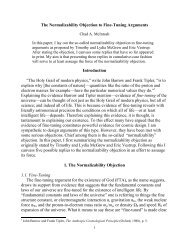Theism and Explanation - Appeared-to-Blogly
Theism and Explanation - Appeared-to-Blogly
Theism and Explanation - Appeared-to-Blogly
Create successful ePaper yourself
Turn your PDF publications into a flip-book with our unique Google optimized e-Paper software.
126 <strong>Theism</strong> <strong>and</strong> <strong>Explanation</strong><br />
7.2 BACKGROUND KNOWLEDGE<br />
A second desideratum for any explanation has <strong>to</strong> do with its relationship <strong>to</strong><br />
our background knowledge. What I wish <strong>to</strong> argue is that consistency with<br />
background knowledge is an explana<strong>to</strong>ry virtue, one that should contribute<br />
<strong>to</strong> our willingness <strong>to</strong> accept a proposed explanation. And proposed theistic<br />
explanations are no exception <strong>to</strong> this rule. They will score poorly when<br />
measured against this criterion, precisely because the agent they posit is so<br />
dissimilar <strong>to</strong> any other with which we are familiar.<br />
But fi rst, what do I mean by “background knowledge”? Background<br />
knowledge is best thought of as those facts of which we are aware independently<br />
of the explanation in question. More precisely, it consists of all<br />
the propositions we have reason <strong>to</strong> regard as true other than the proposed<br />
explanans. But we should also exclude from background knowledge the<br />
fact we are trying <strong>to</strong> explain, for <strong>to</strong> appeal <strong>to</strong> the explan<strong>and</strong>um in support<br />
of the explanans is <strong>to</strong> ask about the latter’s explana<strong>to</strong>ry force. It is <strong>to</strong> ask<br />
whether the hypothesis is, in fact, a potential explanation of the fact <strong>to</strong> be<br />
explained. And that is a prior question <strong>to</strong> the one I am asking here, which<br />
I dealt with in Chapter 6. The point I am making here is this: When the<br />
mechanisms posited by potential explanation are consistent with what we<br />
already know about the world, this can (<strong>and</strong> should) contribute <strong>to</strong> our willingness<br />
<strong>to</strong> accept it. And when they are not consistent with what we already<br />
know about the world, this gives us a reason <strong>to</strong> treat it with suspicion.<br />
Background knowledge, so defi ned, includes successful theories. The<br />
point I am making here is that we should (other things being equal) prefer<br />
those proposed explanations that are consistent with what we already<br />
know about the world. And this means they are consistent not only with<br />
observable facts, but also with our best existing theories. One could apparently<br />
explain the operation of electric light bulbs (<strong>and</strong> even c<strong>and</strong>les) by<br />
proposing that they “suck dark” rather than “emit light.”<br />
Take for example, the dark suckers in the room where you are. There<br />
is less dark right next <strong>to</strong> them than there is elsewhere. The larger the<br />
dark sucker, the greater its capacity <strong>to</strong> suck dark. Dark suckers in a<br />
parking lot have much greater capacity than the ones in this room. As<br />
with all things, dark suckers don’t last forever. Once they are full of<br />
dark, they can no longer suck. This is proven by the black spot on a<br />
full dark sucker. A c<strong>and</strong>le is a primitive dark sucker. A new c<strong>and</strong>le has<br />
a white wick. You will notice that after the fi rst use, the wick turns<br />
black, representing the dark which has been sucked in<strong>to</strong> it. If you hold<br />
a pencil next <strong>to</strong> the wick on an operating c<strong>and</strong>le, the tip will turn<br />
black, because it got in the way of the dark fl owing in<strong>to</strong> the c<strong>and</strong>le.<br />
Unfortunately, these dark suckers have a very limited range. There are<br />
also portable dark suckers. The bulbs in these units can’t h<strong>and</strong>le all<br />
of the dark by themselves, <strong>and</strong> must be aided by a dark s<strong>to</strong>rage unit.<br />
When the dark s<strong>to</strong>rage unit is full, it must be either emptied or replaced



